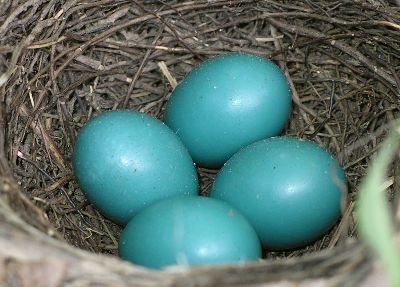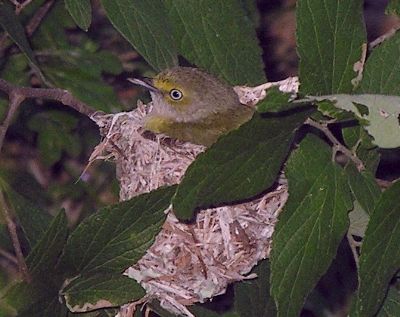
Some birds are into bare-bones minimalism. They don't bother to make a nest and just lay their eggs on the ground. A chuck-will's widow nest that I once found was a perfect example. The little speckled eggs were so perfectly camouflaged that I would never have even suspected they were there if the mother bird hadn't made such a commotion as she flew up from her seat. Even though I was several yards away, it was obvious what she had been up to and a not-so-quick search of the area finally did reveal the eggs. The "nest" moved a bit over the next two weeks. When I came back to check, the tiny babies were several feet away from their original place, and the following week they had moved once again, as if scooting around on the leafy ground.
Killdeer actually do a little bit more in the way of construction on their nests. It is certainly not much more, but they seem to arrange a few small rocks and some gravel into a little barrier around their eggs on the ground. Sometimes they find a ready-made depression which seems perfect for their brood. I once found four killdeer eggs neatly arranged within a paving stone in a parking lot. This was a little used area of the lot, so it might have been safe if it had not been time to repaint the white lines. When I returned several days later, the white paint had covered most of one of the eggs and part of another. However, the parents continued to care for the nest and eventually three babies did fledge. The only egg to die was the one that had the most paint.
Some birds use holes or ledges for their nests. It's a memorable experience to be startled by a vulture diving out of its nest in a low cliff face or to notice a tiny woodpecker sticking its head out of a perfectly round opening carved into a dead agave flower stalk. Of course, many people have bird houses in their yards to provide spaces for the birds that like to stay out of the rain. I once had an elderly neighbor ask me to take a look at something for her. She said she'd been seeing a bird poking its head out of her bird house, but her eyes weren't good enough to make out the kind of bird, and it was a little too high up for her to reach easily. She wanted me to see if the bird was done nesting yet so the box could be taken down and cleaned. Well, when I looked, there was a bird's head in the opening. It was the mummified head of a wren and it must have been dead for at least a month from the desiccated look of the corpse.
Doves seem to build their nests on branches that are incapable of supporting them. They balance a few twigs on the bough, lay their egg, and obviously assume that it will not be windy before their fledgling leaves home. It defies all laws of physics that dove nests remain in the tree at all.
Other birds are not so lucky. We had a cardinal that thought the perfect place for a nest was in a tall shrub near our front door. This would have been fine if we had not had a torrential downpour and if the bird had not chosen to build right under the edge of the eave, where the water funneled down into a miniature Niagara Falls. The next morning the eggs and nest were smashed to the ground.
While some birds are not adept at choosing good nest sites, others have a real knack. A friend recently told me that a vulture nested for years in an abandoned old house that he checks occasionally. He said the bird used to lay its egg in the bathtub, one of those antique porcelain tubs on legs. The vultures used that location for several years. Then, one year there was no egg. As he was leaving the house, my friend said he happened to flash his light around the living room. There, in the center of the floor, was an egg. He figures the birds decided to upgrade their nest to a nicer room.
Nests are, of course, created to suit the size of the bird that uses them. A crane's marshland nest or an eagle's aerie are both huge to accommodate their large size. Nobody can miss an osprey or heron nest, even if they are at quite a distance. A hummingbird nest that I saw, though, was so tiny that it looked like a little clod of dirt high up on one of the branches of a large live oak in our backyard. The only thing that gave it away as a nest was the little head and beak of the parent bird sticking out over the edge.
One of the more interesting nests we find in our area is not welcome by everyone. Monk parakeets, also called Quaker parrots, have been released and survive by building communal nests. These large piles of sticks help the birds endure freezing temperatures but they also tend to obstruct communications towers and can overheat spotlights in such places as sports fields. The maintenance people hate those birds.
 When I was a kid living in Illinois, we frequently found nests of robins and got to see the lovely blue eggs, the ugly little hatchlings, and the charming fledglings. We even sometimes fed worms to the baby birds when their mother wasn't around. It was funny to see the adult return and try to stuff more food into little birds that were already satiated.
When I was a kid living in Illinois, we frequently found nests of robins and got to see the lovely blue eggs, the ugly little hatchlings, and the charming fledglings. We even sometimes fed worms to the baby birds when their mother wasn't around. It was funny to see the adult return and try to stuff more food into little birds that were already satiated.
Here in Texas, it is relatively easy to find wren nests, as they tend to simply find a manmade structure, like a flower pot, and renovate it into a cozy hideaway for their babies. The birds tolerate human activity admirably, much more so than their predators, so they find safe havens and only have to put up with prying eyes.
Sometimes what happens in a nest is not the usual chain of events. While working in the Hartman Prehistoric Garden, located in Zilker Botanical Gardens here in Austin, I found a neatly constructed nest only three feet off the ground. It hung in a tangle of hackberry branches and I saw the parent bird, a white-eyed vireo, sitting on the nest a couple of times. Once, though, I looked into the nest when the adult was away. Instead of four little eggs, there was just one, and it was too large to have been produced by the doting parent. That poor dedicated vireo was incubating a cowbird egg, a common nest parasite in our area.
Observations of our avian neighbors' nests are just one of the little ways we can feel a bit more connected to the rest of the world. The trials and tribulations of home ownership seem to bridge the gaps between species and let us understand just a bit more about life on this planet.